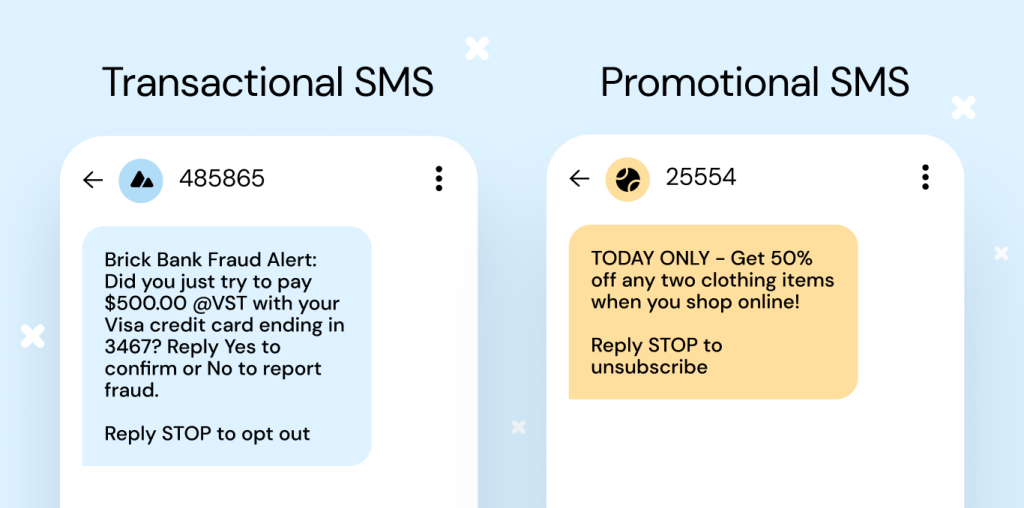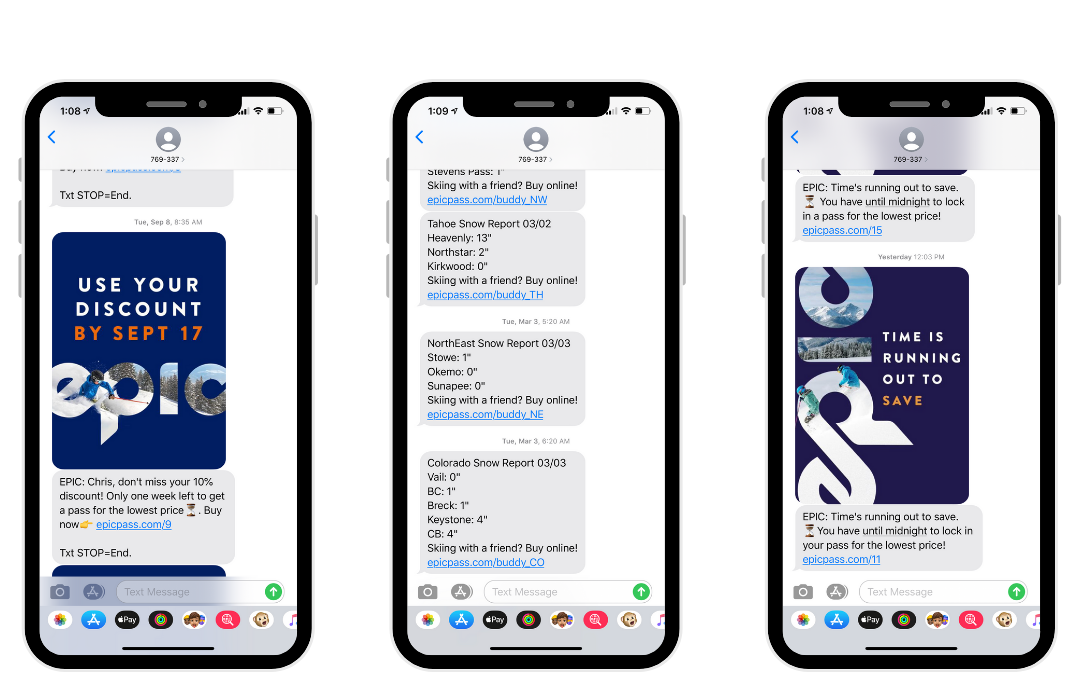Insights
What is SMS marketing? Benefits, insights, and real-world examples

Insights

Most marketers already use Short Message Service (SMS) in some form – sending flash sale alerts, event reminders, or discount codes. But simply using SMS doesn’t mean that you’re maximizing its potential value.
Maybe you have high open rates, but conversions? Not so much. Or you’re sending messages around the globe but getting wildly inconsistent engagement from your subscriber list.
This guide is here to help you move past the basics. You’ll learn what great SMS marketing actually looks like today – with real examples, compliance know-how, and expert-backed strategies that help global brands get measurable results.
Let’s start with the essentials: What SMS marketing is, and why it works.
SMS marketing is the practice of sending promotional content, updates, and special offers to customers through text messages. This direct marketing channel helps your enterprise or small business deliver concise messages (typically limited to 160 characters) directly to consumers’ mobile devices.
The benefits of SMS marketing include immediate visibility that email marketing and social media often can’t match. SimpleTexting’s research shows that 82% of consumers check their notifications within just five minutes of receiving a text, making it a powerful tool for building customer loyalty.
You can use text message marketing for a variety of purposes, like:
As more companies jump in, the channel is becoming more competitive. Alfredo Salkeld, Brand Director at Sinch SimpleTexting discussed this shift during his session at Email Camp 2024, referencing data from a 2024 survey of business owners about how they’re using texting.
“45% more businesses [in 2024] are using text marketing compared to the same time two years ago. More brands than ever are competing for space in the SMS inbox… to compete, you have to stand out.”

There are a few key types of SMS marketing campaigns to keep in mind. To turn SMS into a conversion engine, you’ll need timely promos or relationship-building check-ins that strengthen relationships with loyal customers.
There are two types of SMS that every brand needs to consider: transactional SMS and promotional SMS.

Promotional SMS advertises products, services, deals, coupons, or events to opted-in subscribers. These messages create urgency and prompt people to take actions like:
Promotional SMS sends time-sensitive info straight to people’s mobile phones to grab attention quickly. Retailers could send promotional texts when launching new products or special deals, including strong calls to action like “Shop now” or “Get your code.” Or you could offer a loyalty program incentive to encourage subscribers to take action.
Transactional SMS is operational in nature and provides a customer with information like order confirmations, shipping notifications, account updates, and payment details.
They aren’t necessarily marketing-focused, but will keep customers informed about purchases, accounts, or transactions related to your business while providing excellent customer support.
For instance, an ecommerce brand might send delivery updates post-purchase, or a bank might notify customers of suspicious credit card activity.
In fact, people opt in to SMS for all kinds of reasons. According to SimpleTexting, here’s what tops the list:
of consumers opt into SMS for appointment reminders
of people opt into SMS for shipment tracking and order updates
of people opt into SMS for promotions or sale alerts
of people opt into SMS for customer service and support
Even something as simple as SMS verification messages can reassure customers that their information is secure and their experience is smooth.
SMS marketing starts with one crucial step: getting permission. Before a business can send any marketing text, it must receive an explicit opt-in from the recipient – this is usually through a checkbox on a website or a sign-up form.
This is a legal requirement under regulations like the TCPA and GDPR. Without consent, you risk hefty fines and eroding customer trust before the conversation even starts.
Once a customer opts in, you can build and launch a campaign using SMS marketing tools like Sinch. These systems allow you to segment your audience, schedule messages, personalize content, and track performance metrics like delivery rates, click-throughs, and conversions. They also integrate with your customer relationship management (CRM) software to ensure consistent messaging across channels.
The platform then sends your message to a mobile carrier, which delivers it to subscribers’ phones within seconds. This immediate delivery is what gives SMS its power. Messages are typically read within minutes, creating instant awareness that other channels simply can’t match.
SMS marketing components include:
Getting started with SMS marketing doesn’t mean sending random messages and hoping for clicks. It doesn’t mean overlooking the differences between SMS and email marketing and attempting to attach your new campaign to the tails of an existing program. Successful SMS marketing starts with intention.
In Alfredo’s Email Camp session, he broke down the three key components of every high-performing SMS campaign:
“Texting used to be seen as a one-way, spammy channel. Now, the best brands are treating it as a two-way interaction.”

How you ask people to join your SMS list matters. Generic pop-ups aren’t enough. Alfredo shared a standout example: A local microgreens farmer created “tiny billboards for tiny greens” across their city, turning a budget-friendly idea into a perfect brand fit.
The key takeaway? Make your SMS opt-in campaign feel unique to your brand, because creativity will drive conversions.
Next, define your incentive. Think beyond “10% your next order” – because your customers certainly are.
“People don’t want more texts – they want better ones.”

For a craft fair, Alfredo suggested treating SMS subscribers like an “elite club” by offering exclusive perks like jury positions to help select artists for the next parade – something no discount could match in perceived value or engagement.
Finally, map out your message strategywith proven SMS templates. Once subscribers opt in, what’s next? Think beyond promotions. Instead, deliver content that feels personal, useful, and engaging – not just transactional.
Take the microgreens farmer again. Instead of blasting sales messages, they sent educational “farm-to-phone” updates, showing growing processes and sharing recipe ideas – content the farmer was already creating for other channels.
“Everybody’s an expert in something. Find your unique knowledge and deliver it directly to your subscribers’ phones.”

Try educational content, customer spotlights, or behind-the-scenes updates to make your SMS marketing messages feel more personal and engaging instead of just informational.
SMS is a privilege, not a megaphone. The brands that lead with value, not volume, are the ones that build lasting customer relationships.
We mentioned this before, but it’s super important so we’ll say it again: Before you kick start any type of mobile marketing campaign, you’ll need to build a contact list of people who’ve given you permission to send them SMS messages. Only message people who’ve clearly opted in.
Just because someone signs up for transactional updates doesn’t mean they’ve agreed to get promotional messages. You need their clear consent.
Of course, we aren’t lawyers and none of this information constitutes legal advice, so it’s important to consult with your legal team before starting any new SMS marketing program.
Here are some key best practices to help optimize your SMS marketing strategy:
Messaging is changing fast. SMS is still the go-to, but new tech is introducing new possibilities.
According to Sinch SimpleTexting, 66% of businesses now use SMS marketing – that’s up 55% in just four years. Even more telling? 67% plan to increase their budgets in 2025.
That’s because SMS has an unmatched 82% open rate within five minutes and is becoming a key customer service channel. In fact, 31% of consumers now prefer texting businesses over email or phone.
Now, Rich Communication Services (RCS) is opening new doors. With Apple support for RCS rolling out, businesses can reach almost all smartphone users with upgraded features like branded messages, high-res images, and interactive buttons without needing new opt-ins.
For the 84% of consumers already opted in to business texts (up 35% since 2021), RCS makes messaging even better without changing how they connect.
However, while RCS brings exciting new features, SMS remains essential for universal delivery – especially in regions or on devices where RCS isn’t yet supported. With nearly 100% device compatibility, SMS ensures your message always gets through.
Here’s how SMS marketing is expected to evolve next:
2025 is a year of smarter, more dynamic messaging. Businesses that combine SMS, RCS, and AI-driven personalization will be the ones leading customer engagement.
Nothing’s more convincing than seeing SMS marketing in action. Real campaigns show results, context, and the human decisions behind the numbers.
Here are some case studies that show what works and why.
Currys, the UK’s leading omnichannel tech retailer, relies on Sinch SMS to connect with customers at scale. They send more than 300,000 texts monthly and as many as three million during peak periods like Black Friday.
After integrating with Adobe Campaign Classic to better target their audiences, Currys needed an SMS provider that could deliver reliable, event-driven messaging with minimal friction. Sinch offered the right mix of support, cost-effectiveness, and performance, with a 97.5% delivery rate and 99.9% uptime.
“The kind of opt-out rates that we see on SMS are incredibly low. We also see a high online last-click conversion rate… particularly to the audiences that don’t have email permissions or aren’t engaging with email.”
With Sinch, Currys now delivers secure, GDPR-compliant SMS campaigns that re-engage customers, increase conversions, and enhance the customer journey – especially in segments that email marketing often fails to reach.
Family Quest Entertainment (FQE) hosts more than 200 interactive events annually, attracting thousands of families each weekend. To keep up with demand and ensure high turnout, CEO Chad Collins turned to Sinch’s SMS integration for HubSpot.
The result? Faster event launches, higher engagement, and better ticket sales – all with less manual work.
Watch the video to learn how Family Question Entertainment uses SMS marketing to capture busy customers’ attention and increase event attendance.
With automated, personalized messages sent through HubSpot workflows, FQE delivers the right message to the right audience at the right time. And by freeing up the team from repetitive tasks, they can focus on creating memorable experiences for their audience, one text at a time.
“Sinch is a no-brainer. It’s accessible, customizable, and responsive. We saw strong conversion rates, making it a worthwhile investment.”
With 37 resorts across the U.S., Canada, and Australia, Vail Resorts wanted to elevate its guest experience by making mobile messaging a central part of its customer journey.
Using Sinch’s SMS integration with Adobe Campaign, the resort operator was able to create deeper segmentation, enabling opt-ins for personalized notifications like weather updates and timely lift ticket offers.

The results have been impressive. “We find that when we use SMS as opposed to or in addition to an email, we see an increase in engagement and sometimes purchase rate,” said Matt Reid, Vice President of Omni-Channel Marketing. By delivering helpful, relevant updates – like snow conditions followed by targeted promotions – Vail has built stronger, more profitable customer relationships.
“There are ways for us to be more playful in mobile messaging,” Reid added, noting how SMS stands out from cluttered inboxes.
For Budbee, SMS is a core part of the customer experience that creates meaningful customer engagement and future remarketing opportunities.
With more than 30 million customers across four countries, Budbee uses Sinch SMS to send real-time delivery updates, personalized options, and tracking links, all of which create regular, high-quality touchpoints with the customer.
“SMS has been a vital part of our service since day one. It’s more personal than email or a push notification, and customers get the full Budbee experience with no extra effort.”
These frequent interactions help Budbee build brand affinity and establish a communication channel that they can use for future promotions or service updates.
Thanks to Sinch’s reliable infrastructure and competitive pricing, Budbee cut its communication costs and maintenance time in half while also laying the groundwork for highly-personalized, conversion-friendly SMS remarketing campaigns.
To engage a broad customer base and simplify the shopping journey, French home retailer BUT developed a unified messaging strategy across Rich SMS, RCS, and WhatsApp, with powerful results.
SMS remained an essential piece of this approach, acting as a fallback channel when RCS wasn’t supported on customers’ devices. This ensured no audience segment was left out of their campaigns.
When promoting their “100% Refunded” offer, BUT found that SMS alone couldn’t fully explain the deal. So, with Sinch’s help, they layered in RCS to add animated visuals, clear copy, and actionable buttons. They also used Rich SMS to direct fallback users to an interactive scratchcard experience.
Here’s what that looks like in practice.

These marketing efforts led to a 13.3% click-through rate and €61,000 in extra revenue.
“Relying on Sinch’s advice, we managed to differentiate ourselves with innovative Rich SMS, RCS, and WhatsApp campaigns,” said Sonia Dahech, BUT’s Omnichannel, Traffic, and Data Director. “We doubled our ROI compared to traditional campaigns.”
SMS is a core channel for driving engagement, revenue, and loyalty. But to move beyond the basics, brands need to think in systems, not just individual messages.
The next step? Build an integrated strategy: segment your audience, test RCS alongside SMS, and automate intelligently using SMS marketing software like Sinch.
If you’re ready to go from sending texts to scaling real conversations, explore Sinch’s SMS API or connect with our team to map out what next-level messaging looks like for your brand.